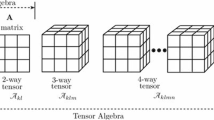Abstract
In recent years sparse representation has been widely used for face recognition and achieved good results. Most sparse representation methods need a redundant dictionary to solve sparse coefficients. And the number of atoms must be much larger than the dimension of atoms in the dictionary. So the design of redundant dictionary is very important for improving the performance of sparse representation methods. By experiments we find that feature fusion (LBP, Gabor, Hog, and raw pixels) after PCA can remain a high recognition rate, which means the feature fusion can represent faces well with a low dimension. So we can use the dictionary based on feature fusion to solve small sample size problem in LDA without losing useful information. And LDA can increase between-class scatter and decrease within-class scatter while reducing the dimensionality, which can build a better structure for redundant dictionary. Based on above we propose a linear discriminative redundant dictionary based on feature fusion to improve the performance of face sparse representation methods, namely, LDRD. Firstly, extract and concatenate a standard set of features (LBP, Gabor, Hog, and raw pixels) to form a feature vector as the atoms, then introduce LDA to rebuild the dictionary of atoms, to reduce dimensionality and enhance the discriminative ability of the dictionary. We compare LDRD with the dictionary based on downsampling and feature fusion for SRC, CRC_RLS and LASRC. The extensive experiments demonstrate that the proposed dictionary has better recognition rate and operating efficiency, while it can easily reject distractor faces.















Similar content being viewed by others
References
Ahonen T, Hadid A, Pietikainen M (2006) Face description with local binary patterns: application to face recognition. IEEE Trans Pattern Anal Mach Intell 28(12):2037–2041
Becker BC, Ortiz EG(2013) Evaluating open-universe face identification on the web. IEEE Conf Comput Vis Pattern Recogn Workshops 904–911
Becker BC, Ortiz EG (2013) Evaluating open-universe face identification on the web. IEEE Conf Comput Vis Pattern Recogn Workshops 904–911
Belhumeur PN, Hespanha JP, Kriegman DJ (1997) Eigenfaces vs. fisherfaces: recognition using class specific linear projection. IEEE Trans Pattern Anal Mach Intell 19(7):711–720
Cai D, He X, Han J, Huang TS (2011) Graph regularized nonnegative matrix factorization for data representation. IEEE Trans Pattern Anal Mach Intell 33(8):1548–1560
Déniz O, Bueno G, Salido J, De la Torre F (2011) Face recognition using histograms of oriented gradients. Pattern Recogn Lett 32(12):1598–1603
Figueiredo MA, Nowak RD, Wright SJ (2007) Gradient projection for sparse reconstruction: application to compressed sensing and other inverse problems. IEEE J Sel Top Sign Proces 1(4):586–597
Georghiades AS, Belhumeur PN, Kriegman DJ (2000) From few to many: generative models for recognition under variable pose and illumination. In Automatic Face and Gesture Recognition 2000. Proc Fourth IEEE Int Conf 277–284
Howland P, Wang J, Park H (2006) Solving the small sample size problem in face recognition using generalized discriminant analysis. Pattern Recogn 39(2):277–287
Huang GB, Ramesh M, Berg T, Learned-Miller E (2007) Labeled faces in the wild: a database for studying face recognition in unconstrained environments (Vol. 1, No. 2, p. 3). Technical Report 07–49, University of Massachusetts, Amherst
Lange J, von der Malsburg C (1989) Distortion invariant object recognition by matching hierarchically labeled graphs. IEEE Int Joint Conf Neural Netw 155–159
Martinez AM (1998) The AR face database. CVC technical report, 24
Ortiz EG, Becker BC (2014) Face recognition for web-scale datasets. Comput Vis Image Underst 118:153–170
Pinto N, Stone Z, Zickler T, Cox D (2011) Scaling up biologically-inspired computer vision: A case study in unconstrained face recognition on facebook. IEEE Comput Soc Conf Comput Vis Pattern Recognit Workshops 35–42
Shi Q, Eriksson A, Van Den Hengel A, Shen C (2011) Is face recognition really a compressive sensing problem? IEEE Conf Comput Vis Pattern Recognit 553–560
Wright J, Yang AY, Ganesh A, Sastry SS, Ma Y (2009) Robust face recognition via sparse representation. IEEE Trans Pattern Anal Mach Intell 31(2):210–227
Zhang L, Yang M, Feng X (2011) Sparse representation or collaborative representation: Which helps face recognition? IEEE Int Conf Comput Vis 471–478
Zhang H, Zha ZJ, Yang Y, Yan S, Chua TS (2014) Robust (semi) nonnegative graph embedding. IEEE Trans Image Proces 23(7):2996–3012
Acknowledgments
The authors would like to thank Dr. Zhizhen Liang for helpful and informative discussion on face recognition and the design of experiments. This work was supported by the National High Technology Research and Development Program of China (Grant No. 2012AA0622022 and Grant No. 2012AA011004), the Doctoral Fund of Ministry of Education of China (Grant No. 20100095110003 and Grant No. 20110095110010), the Fundamental Research Funds for the Central Universities under Grant (Grant No. 2013XK10), the National Natural Science Fund (Grant No. 61402482) and the key project of coal union fund under the National Natural Science Fund (Grant No. U1261201).
Author information
Authors and Affiliations
Corresponding author
Rights and permissions
About this article
Cite this article
Meng, F., Tang, Z. & Wang, Z. An improved redundant dictionary based on sparse representation for face recognition. Multimed Tools Appl 76, 895–912 (2017). https://doi.org/10.1007/s11042-015-3083-6
Received:
Revised:
Accepted:
Published:
Issue Date:
DOI: https://doi.org/10.1007/s11042-015-3083-6




